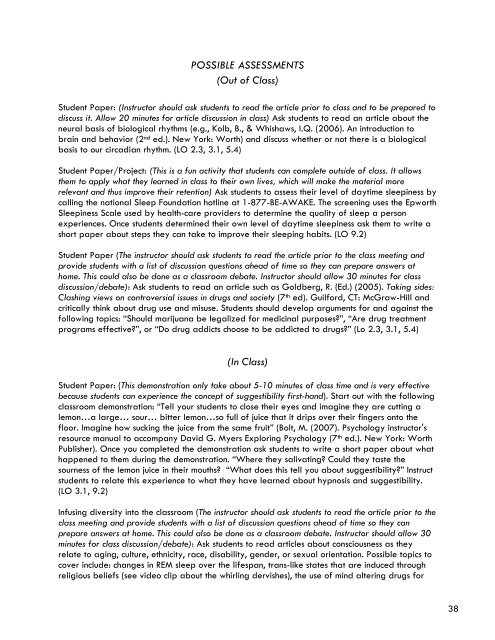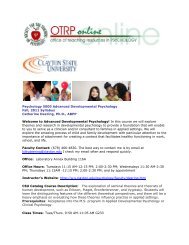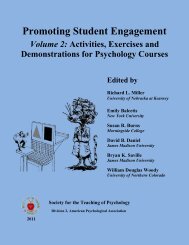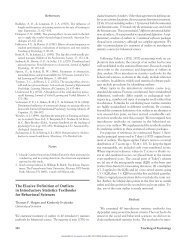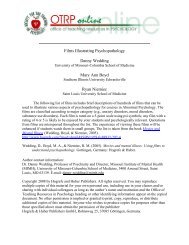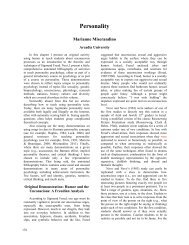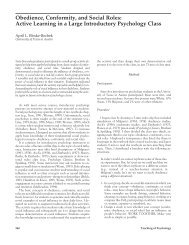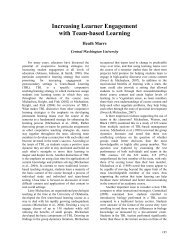INTRODUCTORY PSYCHOLOGY TEACHING PRIMER Early Career ...
INTRODUCTORY PSYCHOLOGY TEACHING PRIMER Early Career ...
INTRODUCTORY PSYCHOLOGY TEACHING PRIMER Early Career ...
Create successful ePaper yourself
Turn your PDF publications into a flip-book with our unique Google optimized e-Paper software.
POSSIBLE ASSESSMENTS<br />
(Out of Class)<br />
Student Paper: (Instructor should ask students to read the article prior to class and to be prepared to<br />
discuss it. Allow 20 minutes for article discussion in class) Ask students to read an article about the<br />
neural basis of biological rhythms (e.g., Kolb, B., & Whishaws, I.Q. (2006). An introduction to<br />
brain and behavior (2 nd ed.). New York: Worth) and discuss whether or not there is a biological<br />
basis to our circadian rhythm. (LO 2.3, 3.1, 5.4)<br />
Student Paper/Project: (This is a fun activity that students can complete outside of class. It allows<br />
them to apply what they learned in class to their own lives, which will make the material more<br />
relevant and thus improve their retention) Ask students to assess their level of daytime sleepiness by<br />
calling the national Sleep Foundation hotline at 1-877-BE-AWAKE. The screening uses the Epworth<br />
Sleepiness Scale used by health-care providers to determine the quality of sleep a person<br />
experiences. Once students determined their own level of daytime sleepiness ask them to write a<br />
short paper about steps they can take to improve their sleeping habits. (LO 9.2)<br />
Student Paper (The instructor should ask students to read the article prior to the class meeting and<br />
provide students with a list of discussion questions ahead of time so they can prepare answers at<br />
home. This could also be done as a classroom debate. Instructor should allow 30 minutes for class<br />
discussion/debate): Ask students to read an article such as Goldberg, R. (Ed.) (2005). Taking sides:<br />
Clashing views on controversial issues in drugs and society (7 th ed). Guilford, CT: McGraw-Hill and<br />
critically think about drug use and misuse. Students should develop arguments for and against the<br />
following topics: “Should marijuana be legalized for medicinal purposes?”, “Are drug treatment<br />
programs effective?”, or “Do drug addicts choose to be addicted to drugs?” (Lo 2.3, 3.1, 5.4)<br />
(In Class)<br />
Student Paper: (This demonstration only take about 5-10 minutes of class time and is very effective<br />
because students can experience the concept of suggestibility first-hand). Start out with the following<br />
classroom demonstration: “Tell your students to close their eyes and imagine they are cutting a<br />
lemon…a large… sour… bitter lemon…so full of juice that it drips over their fingers onto the<br />
floor. Imagine how sucking the juice from the same fruit” (Bolt, M. (2007). Psychology instructor's<br />
resource manual to accompany David G. Myers Exploring Psychology (7 th ed.). New York: Worth<br />
Publisher). Once you completed the demonstration ask students to write a short paper about what<br />
happened to them during the demonstration. “Where they salivating? Could they taste the<br />
sourness of the lemon juice in their mouths? “What does this tell you about suggestibility?” Instruct<br />
students to relate this experience to what they have learned about hypnosis and suggestibility.<br />
(LO 3.1, 9.2)<br />
Infusing diversity into the classroom (The instructor should ask students to read the article prior to the<br />
class meeting and provide students with a list of discussion questions ahead of time so they can<br />
prepare answers at home. This could also be done as a classroom debate. Instructor should allow 30<br />
minutes for class discussion/debate): Ask students to read articles about consciousness as they<br />
relate to aging, culture, ethnicity, race, disability, gender, or sexual orientation. Possible topics to<br />
cover include: changes in REM sleep over the lifespan, trans-like states that are induced through<br />
religious beliefs (see video clip about the whirling dervishes), the use of mind altering drugs for<br />
38


